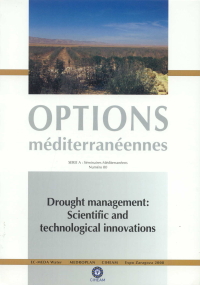| Article précédent | p. 179-184 | Article suivant |
Drought management and planning strategies in semi-arid and arid agro-pastoral systems of West Asia and North Africa: a review
The dry areas of West Asia and North Africa (WANA) region are characterized by low rainfall and high fluctuation of the precipitation. The rural livelihoods of these areas are based on agro-pastoral systems of production. These systems have been fragilized by drought that has become more frequent and worsened by human activities. To ensure the long term management of drought and improve and sustain these systems' productions and hence the livelihood of the agro-pastoralists, there is a need for the development of a risk and long term management approach of drought. This requires active participation of the different stakeholders and disciplines in an integrated way. In this process, the use of scientific approaches and methods are valuable and hence the involvement of research institutions is a pre-requisite for any improvement of drought management systems in the region; that is why this study is conducted as a component of a research project conducted jointly by ICARDA and a group of National Research Programs of WANA entitled Developing Sustainable Livelihood of Agro-pastoral Communities of West Asia and North Africa. The objectives are: (i) to analyze the existing national, regional and international strategies and policies of drought preparedness and mitigation; and (ii) to assess existing technologies and propose new and more adapted options of risk management of drought for the region. This study showed that indigenous and local community strategies of drought management are no longer effective in coping with drought and the action plans that have been launched by the governments to manage this climatic hazard are mostly crisis based programs that encourage the dependency of the producers on the States aids and supports. This dependency has increased the use of non-adapted drought management that worsens the degradation of rangeland and pastures, and hence reduces livestock production and herders income. To improve their drought plans, WANA countries should build their systems on research results and on the experiences of some advanced countries that have developed comprehensive systems of drought risk management. In fact, scientists have developed methods that can be used in early drought warning such as drought indices and remote sensing tools and techniques that can mitigate better drought effects. Unfortunately, most of the studies on drought early warning that have been undertaken concerned crop production and a little effort has been made in relation with range and agro-pastoral systems. Nevertheless, experiences of some countries of Eastern and Western countries of Africa, Australia and New Zealand that tested drought risk management approaches in agro-pastoral sectors can be helpful in developing those adapted to WANA conditions. In fact, in this study, an integrated potential drought risk management system for WANA is proposed. It is based on early warning (Standardized Precipitation Index, S
- [ Afficher ]
- [ Télécharger ]
- [ Exporter la citation ]
Vous pouvez télécharger la citation au format :
- [ Imprimer ]
-
Mots-clés
AFRIQUE DU NORD, ASIE OCCIDENTALE, GESTION DU RISQUE, PROJET DE RECHERCHE, SECHERESSE, SYSTEME AGROPASTORAL, TECHNIQUE DE PREVISIONCiter cet article
Karrou M., El Mourid M. Drought management and planning strategies in semi-arid and arid agro-pastoral systems of West Asia and North Africa: a review. In : López-Francos A. (ed.). Drought management: scientific and technological innovations. Zaragoza : CIHEAM, 2008. p. 179-184. (Options Méditerranéennes : Série A. Séminaires Méditerranéens; n. 80). 1. International Conference Drought Management: Scientific and Technological Innovations, 2008/06/12-14, Zaragoza (Spain). http://om.ciheam.org/om/pdf/a80/00800439.pdf



